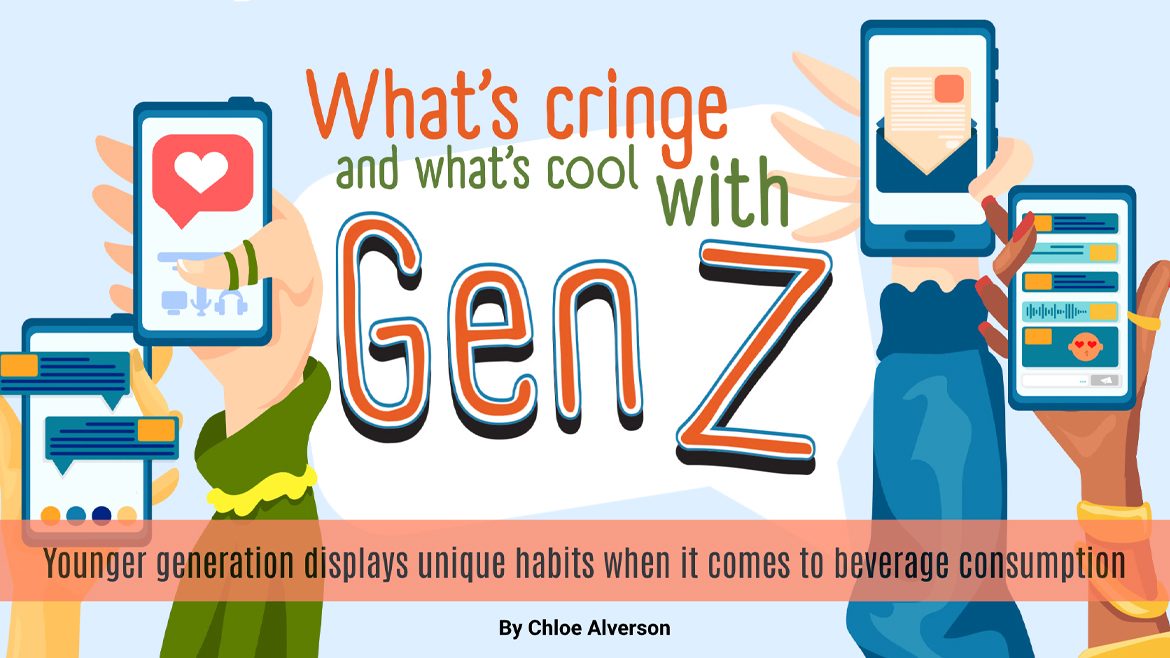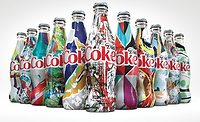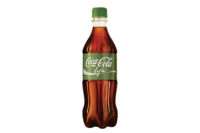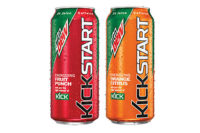Soft drink report
![]()
Soft drink report
Soft drink companies
labored to maintain positive results after a year wrought with job cuts,
reorganization, school vending controversies and a bad rap in the fight
against obesity in this country. But while soft drink consumption trends
remain static in the United States, product innovation gave the category a
needed boost during 2003.
Flavors and diet soft drinks paved the way to positive
results for many soft drink manufacturers during 2003, according to
Information Resources Inc., and ACNielsen. Pepsi-Cola Co.'s Sierra
Mist experienced a 144 percent jump in volume sales, and Dr Pepper/Seven
Up's DNL sales were up more than 1,200 percent during their first
full year on the market (Sierra Mist's first full year in national
distribution). Orange-flavored Mountain Dew liveWire, which was only
available from Memorial Day until Labor Day, was possibly the most daring
lightening-speed introduction and sought-after soft drink during 2003,
while colas with lemon became less attractive to buyers.
In addition to paying attention to flavors, U.S.
consumers also were watching the calorie content of the beverages they
purchased in 2003. Diet soft drinks were the focus of marketing campaigns,
led trends in beverage formulation and provided a needed boost in sales for
manufacturers last year.
Among the leaders in the diet category, Diet Vanilla
Coke shot up more than 397 percent in volume sales, according to IRI.
Additionally, Pepsi's Diet Sierra Mist climbed to an almost 250
percent volume increase as newcomers to the market in 2003.
But it wasn't only the liquid that soft drink
companies were concerned with in 2003. Pricing was a key variable in the
success products had on the shelf. As Pepsi and Coca-Cola brands continued
a pricing battle in store aisles, private label continued to move
full-steam ahead in its quest to maintain and expand shelf space.
Coca-Cola overcomes challenges
From job cuts throughout North America in the
beginning of the year to the $10-million Burger King frozen Coke lawsuit
during the fall, The Coca-Cola Co. experienced a turbulent year. In the
United States, the loss of 1,000 jobs and reorganization of the
company's bottle/can, fountain and Minute Maid product divisions were
only part of the challenges Coca-Cola faced in 2003. Due to the
reorganization, a management shakeout also ensued. The company named Steve
Heyer president and chief operating officer, and Daniel Palumbo chief
marketing officer, and later, senior vice president in 2003. Management
uncertainty is likely to continue in 2004 when Chairman Doug Daft retires
from the company.
There was a silver lining in the cloud that hovered over Coca-Cola
in 2003. In the first quarter, the company's retail division reported 2 percent
gains in sales compared with results in 2002 due to Vanilla Coke, Diet Vanilla
Coke and Diet Coke as well as continued success of the Fridge Pack, according
to the company.
Year-end figures show that Coca-Cola's overall
sales slipped 4 percent, with positive results reported only in the drug
category of 2.5 percent. Coke with Lemon took a hit in 2003, registering an
overall drop of 57.2 percent in volume sales from last year. However, the
brand's cherry and vanilla renditions picked up some of the slack
with 33.2 percent and 22.6 percent increases, respectively, in sales
compared to the previous year. Furthermore, the introduction of Sprite
Remix gave the company and the category a boost in 2003, lending to
Sprite's trademark volume increase of 4 percent, according to
Coca-Cola.
The company also introduced Barq's Floatz,
initially in Southern states, in its attempts to revive the popularity of
the trademark, and Swerve launched in school vending programs. Both
products were designed to appeal to a younger demographic, while the latest
innovation, Diet Coke with Lime, is expected to grab adult consumers with
its unique taste.
In addition to new product introductions, packaging
such as the catchy Vanilla Coke labels debuted during the summer, helped
the brand compete with Pepsi Vanilla's launch. Coca-Cola also
successfully wooed the Milford, Conn.-based Subway sandwich chain to drop
Pepsi products in its outlets worldwide, which previously accounted for 85
percent of Subway's beverage business, and pick Coca-Cola as its
exclusive beverage supplier.
Pepsi-Cola moving ahead
The Pepsi-Cola Co. had a bustling 2003 filled with
product launches and organizational changes of its own. Beginning the
summer selling season with limited-edition Mountain Dew LiveWire and
launching Vanilla Pepsi at the end of the summer, the Purchase, N.Y.-based
company recorded positive sales results in all channels, except for mass
merchandise, according to IRI and ACNielsen. While Coca-Cola suffered a
slight decrease in category volume
share, Pepsi reported a slight gain compared with last year. Although the brand's regular colas felt a 3.2 percent hit from last year, Pepsi flavors, including the Sierra Mist family of products, and Diet Cherry Pepsi, experienced increased sales of 144 percent and 68.9 percent, respectively.
share, Pepsi reported a slight gain compared with last year. Although the brand's regular colas felt a 3.2 percent hit from last year, Pepsi flavors, including the Sierra Mist family of products, and Diet Cherry Pepsi, experienced increased sales of 144 percent and 68.9 percent, respectively.
Introduced in August, Pepsi Vanilla and Diet Pepsi
Vanilla had Smith Barney analysts predicting that consumption in the
vanilla cola category would continue to expand based on its 2003
performance. However, as a second entry into the market, Pepsi Vanilla may
only add to Coca-Cola's success. Analyst expectations are that
Vanilla Coke sales will rebound in 2004 due to increased media attention
devoted to vanilla colas. And the most recent decision to launch Pepsi
Edge, a mid-calorie cola, will have analysts watching with a close eye in
2004.
In other company news, Pepsi decided to capitalize on
the success of tea during the past year by entering into a joint agreement
with Unilever to market and distribute Lipton ready-to-drink teas. Pepsi
Lipton International builds on the partnership formed early in the 1990s as
a way to enhance portfolio strength for the two companies. Later in the
year, the company announced it was dividing its North American operations
into three core businesses. It proceeded to cut 750 jobs while
consolidating into Pepsi-Cola, Gatorade and juice divisions to streamline
manufacturing and supply chain operations.
Cadbury consolidates U.S. business
Dr Pepper/Seven Up Inc. was no stranger to change in
2003. Similar to the competition, the company struggled with decreasing
sales and challenges due to organizational changes. As part of ongoing
regional changes implemented by parent company Cadbury Schweppes plc, its
three North American beverage units moved closer to consolidation. The goal:
to create a united beverage group that includes Dr Pepper/Seven Up,
Snapple and Mott's organizations under the leadership of Cadbury
Schweppes Americas Beverages President and Chief Executive Officer Gil
Cassagne. Mike McGrath, former president of Dr Pepper/Seven Up, was named
president of sales for the division, and Jim Johnston, senior vice
president of strategy, heads the Americas Beverage strategy group
headquartered in Plano, Texas.
Although the company's overall channel sales for
all brands dropped more than 3 percent from the previous year, 7 Up's
DNL showed impressive results. According to IRI and ACNielsen, DNL
reported a more than 1,700 percent increase in grocery store sales and a
more than 1,500 percent increase in drug store sales during its market
debut in 2003.
The company's focus on diet products in its
advertising and marketing spending toward the end of 2003 is apparent in
the continued success of Diet Dr Pepper. The diet soft drink reported a 5
percent increase in sales overall, and a 10 percent increase in the
convenience and grocery channel.
Private buys
Much to the disappointment of nationally branded soft
drink companies in the U.S. market, the private label bonanza continues and
is building recognition among consumers on the retail shelf. Across all
retail categories, excluding mass merchandise, private label colas and
flavored soft drinks saw sales increases. A particularly strong outlet for
private label proved to be the convenience and gas channel, averaging an
almost 37 percent increase in sales compared with 2002, according to IRI
and ACNielsen.
The surge in convenience store private label sales is
no surprise considering Cott Corp., Toronto, Ontario, the world's
largest store-brand soft drink producer, announced in April that it would
tap convenience stores for future growth. Cott Corp. reported record
results for 2003 and saw sales rise 18 percent to finish the year with $1.4
billion in revenue, excluding acquisitions. Its U.S. business accounted for
17 percent of the company's total growth.
Former head of Cott's U.S. division, John K.
Sheppard was named president and chief executive officer in July. Sheppard
plans for 2004 include taking advantage of opportunities in not only the
United Kingdom and Mexico, but also in North America by strengthening
Canada-U.S. ties. The company has already moved to expand its customer base
in the mid-Atlantic states by acquiring North Carolina's Quality
Beverage Brands LLC. The agreement also involves Independent Beverage
Corp., which is expected to add approximately $45 million in annual sales.
Soft drink sales bright abroad
According to a recent report published by Euromonitor,
Chicago, carbonate sales in mature markets such as North America and
Western Europe have remained static during the past five years. However,
there is some light at the end of the tunnel. The report points out that
low-calorie soft drinks in these established markets and non-cola
carbonates in other global markets maintained a healthy growth spurt during
this time.
In Euromonitor's report titled "Carbonates: The
battle for share in emerging markets," analysts suggest the United
States, which boasted 200 liters per-capita consumption in 2003, is
suffering from saturated demand as well as negative publicity about obesity
and diabetes rates among children. The slide is further attributed to the
consumer trend to buy functional beverages such as enhanced bottled waters
— a trend Euromonitor predicts will continue into the future.
Non-cola soft drinks
Emerging regions such as Asia-Pacific and Eastern
Europe have experienced strong carbonates growth during the past five
years, according to the report. More specifically, countries such as
Romania, Ukraine, India, China and Mexico have contributed to the
regionally reported volume growth of total carbonates in both on- and
off-premise. Growth rates in Asia-Pacific and Eastern Europe were 22
percent and 18 percent, respectively, from 1998 to 2003. Latin America also
demonstrated more than 16 percent volume growth for other non-cola
carbonates, including brands such as Antarctica and Kuat.
Euromonitor attributes the chief spur of carbonate
growth to activity in non-cola carbonates, either through the launch of new
flavors or the popularity of local generic brands. Multinationals have been
exploiting local brands by launching their own private label soft drinks or
buying into existing brands.
One example of multinational dominance in the soft
drink market is Romania, which enjoyed the highest carbonate growth in the
world in 2003 — almost 84 percent — as a result of flavor
introductions. Beginning in 2001, Coca-Cola launched the Fanta Berries line
of soft drinks in Romania, which includes three flavors: Fanta Madness, a
grape-flavored soft drink; Fanta Shokata, with elderflower and lemon
flavors, and Fanta Green Apple.
The company also launched Smart brand soft drinks in
China in flavors such as Apple & Banana and Pineapple & Mango,
which emphasized "local flavor." According to the report,
non-cola carbonates in China also saw high growth over the review period.
Local flavor focus
Flavors are top of mind to multinationals entering markets throughout
the world. However, attention to local products and consumer tastes are key
to launching a product in an emerging market.
In Russia, where non-colas
account for more than 55 percent of soft drink volumes, traditional
Soviet-era products such as Baikal, Tarkhun, Kolokolchik, Ruratino and
Kvas, a fermented sparkling non-cola beverage, are becoming more popular.
In response, Coca-Cola has launched its own version of Kvas called
Frukatim.
But it is not only in Russia where Soviet-era brands
have loyalists. In the Czech and Slovak Republics, Kofola, a cola with a
different flavor profile than U.S. colas, has seen a revival in sales
during the past five years.
South of the border
Venezuela and Brazil also are home to local non-cola success
stories. With malta in Venezuela and guarana in Brazil, multinational companies
interested in entering these markets have tough competition among local producers
of these market-dominating beverages.
Malta, or carbonated malt drink, which accounts for 70
percent of Venezuela's off-premise sales of other non-cola
carbonates, is considered a nutritious plant-based substitute to cola
carbonates, according to Euromonitor. The beverage is produced mainly by
local beer producers, and currently has no international competition and no
multinational presence. The leading malta brand, Maltin Polar, produced by
Empresas Polar, is the third most popular soft drink brand in the country
after Coca-Cola and Pepsi.
Neighboring Brazil has experienced multinational
activity in the non-cola soft drink sector as interest in guaraná, a
red berry from the Amazon, continues to exist. Considered a stimulant with
an active ingredient similar to caffeine, guarana has been a popular soft
drink ingredient in Brazil for years, and competes directly against cola
carbonates in Latin America.
AmBev, the second-largest carbonate manufacturer in
Brazil with a share of less than 10 percent, owns Guaraná
Antarctica, which is the country's leading brand. Coca-Cola is
present in Brazil with its Kuat brand, which has been marketed under the
brand name Senzao in Mexico since 2001, and has planted additional acres of
guarana in preparation for the increase in demand, according to
Euromonitor.
Cola wars extend past U.S. border
Although it appears that small producers in global
markets have the upper hand as local experts
with a loyal fan base for their products, Coca-Cola and PepsiCo dominate
the carbonates sector abroad through acquisition or joint venture and the
financial muscle to see them realized. The two cola giants also have
advertising spending power and the pull to align with national sporting and
music events in these markets. Price sensitivity still remains a factor for
consumers in emerging markets, and private label is also expanding its
reach abroad.
Asia-Pacific top draw
For companies that want to test the water in emerging
markets, future growth in soft drinks will be driven by non-cola carbonates and low-calorie colas, according to Euromonitor.
Asia-Pacific is predicted to experience the highest overall volume growth during the next six years, led by countries such as China and India. Eastern European nations of Romania and Ukraine, and Latin American countries such as Argentina and Venezuela will see approximately 17 percent growth. Throughout the world, manufacturers will be enhancing their products, differentiating their brands and stimulating customer loyalty, all while fighting price pressures in the future. BI
| Global carbonate retail volume (in million liters) | |||
| Subsector | 1997 | 2003 | 2008 |
| Carbonates | 117,466.8 | 135,971.1 | 149,187.7 |
| Cola carbonates | 67,979.6 | 77,107.2 | 83,427.2 |
| Standard cola carbonates | 52,985.7 | 57,701.3 | 60,429.2 |
| Low calorie cola carbonates | 12,936.1 | 16,146.1 | 18,977.7 |
| Other cola carbonates | 2,057.8 | 3,259.8 | 4,020.3 |
| Non-cola carbonates | 49,487.1 | 58,863.9 | 65,760.5 |
| Lemonade/lime carbonates | 15,363.7 | 17,423.6 | 18,770.9 |
| Orange carbonates | 11,069.3 | 13,168.2 | 14,902.1 |
| Mixers | 3,093.2 | 3,172.0 | 3,410.0 |
| Other non-cola carbonates | 19,961.0 | 25,100.0 | 28,677.5 |
| Source: Euromonitor International — Global Soft Drinks Market Information System, 2004 | |||
| Global carbonate per-capita unit consumption (liters per head) | |||||
| Subsector | 1997 | 2003 | 2008 | Percent Growth 1997-2003 | Percent Growth 2003-2008 |
| Carbonates | 20.2 | 21.6 | 22.4 | 10.6 | 9.7 |
| Cola carbonates | 11.7 | 12.2 | 12.5 | 8.6 | 8.2 |
| Standard cola carbonates | 9.1 | 9.2 | 9.1 | 4.4 | 4.7 |
| Low calorie cola carbonates | 2.2 | 2.6 | 2.8 | 19.2 | 17.5 |
| Other cola carbonates | 0.4 | 0.5 | 0.6 | 51.7 | 23.3 |
| Non-cola carbonates | 8.5 | 9.3 | 9.9 | 13.4 | 11.7 |
| Lemonade/lime carbonates | 2.6 | 2.8 | 2.8 | 8.7 | 7.7 |
| Orange carbonates | 1.9 | 2.1 | 2.2 | 11.9 | 13.2 |
| Source: Euromonitor International — Global Soft Drinks Market Information System, 2004 | |||||
2003 Soft drink sales by volumeVIEW TABLE
Soft drink volume by brand — The Coca-Cola Co.VIEW TABLE
Looking for a reprint of this article?
From high-res PDFs to custom plaques, order your copy today!






